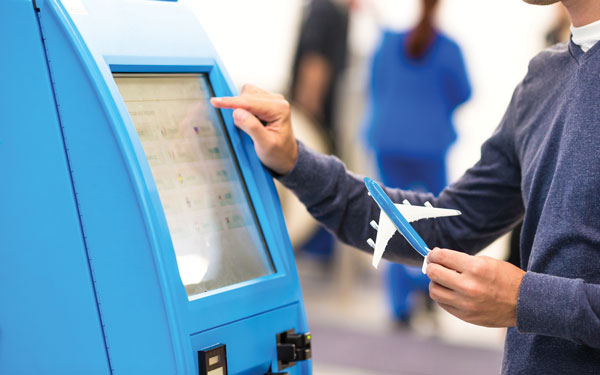Providing passenger friendly airport technology
- Like
- Digg
- Del
- Tumblr
- VKontakte
- Buffer
- Love This
- Odnoklassniki
- Meneame
- Blogger
- Amazon
- Yahoo Mail
- Gmail
- AOL
- Newsvine
- HackerNews
- Evernote
- MySpace
- Mail.ru
- Viadeo
- Line
- Comments
- Yummly
- SMS
- Viber
- Telegram
- Subscribe
- Skype
- Facebook Messenger
- Kakao
- LiveJournal
- Yammer
- Edgar
- Fintel
- Mix
- Instapaper
- Copy Link
Posted: 4 April 2016 | Dieter A. Heinz, President of the GATE alliance | No comments yet
Enhancing the passenger experience is a goal for airlines and airports alike. Dieter A. Heinz, President of the GATE alliance, considers how we can continue to better serve our passengers through the use of technology…


Airports connect and move people – literally and figuratively. As passenger numbers increase, so do demands for airport comfort and the speed with which they get things done. The demand for intelligent and sophisticated products and services is rising rapidly. The entire industry is challenged to develop new ideas and innovative technologies of the highest quality. GATE, the German Association for Airport Technology and Equipment, with its 50 members representing German airport suppliers, is dedicated to meeting the challenges of airport technology, equipment and services.
As the leading platform for the airport industry, GATE is also the first place to turn for new construction and modifications at airports, making it a gateway to the most innovative companies and a hub for the latest information and technology developments. GATE harnesses a huge pool of knowledge that the entire industry, worldwide, can benefit from.
Terminals – the heart of every airport
Increasing emphasis is now placed on passenger convenience, with business and private travellers alike expecting short waiting times for check-in, baggage drop, security checks and boarding. In addition, passengers like to feel safe and calm at the airport. GATE members, who supply terminal technologies, provide innovative solutions and products to meet those requirements. Within the terminal sector various member companies cover the whole process; from entering the terminal to boarding the aircraft.
Looking ahead to the summer, European airports will see increased passenger traffic and baggage. Enhancing the passenger experience is a goal for airlines and airports alike, so how can we continue to better serve our passengers through the use of technology? Recently GATE member, BEUMER Group, published a Whitepaper about the IATA Resolution 753 that will take effect in 2018. The paper, which discusses the future of baggage handling compliance, was well received by the industry and includes more information on the Resolution, minimum requirements, potential challenges and also identifies appropriate solutions for all involved.
The aim of IATA Resolution 753 is to reduce the number of lost or misrouted items of baggage by requiring member airlines to maintain an accurate inventory of baggage by monitoring the acquisition and delivery of baggage. In order to comply with Resolution 753, airlines must be able to demonstrate the delivery and acquisition of bags at three key checkpoints: aircraft loading, arrivals inject and transfers inject. Airlines must also provide an inventory of baggage on the departure of a flight and, crucially, be capable of exchanging data on these events with other airlines. Reducing misrouted baggage not only saves airlines money – as demonstrated in the SITA 2015 Baggage Report, stating a saving of US$18 billion – but also increases passenger satisfaction.
To help airlines and airports in their mission to deliver a first class customer experience, BEUMER Group has also come up with a solution to the major hurdle of unreadable bag tags, especially pertinent for connecting flights. At present, baggage handling staff face pressure to re-direct the luggage accurately, often within a small timeframe, and avoiding short shipments. The majority of luggage can be easily processed through a fully-automated baggage handling system (BHS) but periodically bags with unreadable tags must be directed to a manual encoding station (MES). This diversion adds extra time and, in unusual cases where the bag source message (BSM Data) is not available, this can cause delays that can lead to a high number of short-shipped bags, incurring high costs for the airport and airlines and leaving passengers unhappy.
By introducing a video coding system (VCS) with cameras into the BHS, the bag need not be diverted to an MES, as an image of the tag is sent via the VCS to an operator who encodes the information remotely at a workstation or via a tablet. Using a VCS ensures baggage flow is not interrupted, short shipments are reduced, and passengers have a positive experience.
There are no quick-fix solutions. Full co-operation is needed between the airlines, ground handlers and airports. Investing in improved baggage handling technology will not only benefit the airlines, airports and ground handlers, but will also mean that significantly fewer passengers will experience frustration.
Another solution to accelerate proceedings comes from GATE member, Materna. Self-bag drop is one of the most important topics for on-the-ground passenger handling at airports. Automation of this key process will bring many advantages for growing airports. They have to increase their efficiency and at the same time provide optimum services for their passengers. Materna’s response is to offer the new Self-Bag Drop Kiosk, Merkur. As a compact retrofit solution, Merkur provides all the functions required by a modern self-bag drop system, such as scanning of identification documents, printing of bag tags or paying for excess luggage. Due to ever-increasing passenger traffic, airports and airlines are increasingly relying on self-service offers. Airports can not only store the new solution easily but can also make use of the existing infrastructure.
A retrofit solution, Merkur is the most recent development in a series of self-bag drop systems and allows passengers to easily drop off their luggage at the airport. Passengers can scan their boarding pass and print out the appropriate bag tags for their bags themselves at the machine. Merkur also provides a liner-less bag tag that is particularly easy to handle due to a special coating. For overweight baggage or a higher number of pieces of luggage, the users of the self bag drop system may use their credit card to pay the relevant fee directly at the machines. Thus, the airport saves the hassle of baggage drop at the counter and still complies with the prescribed safety regulations.
When it comes to noise reduction, doors can be equipped with quality rollers made by RAEDER-VOGEL. The sliding and revolving doors are the first impression passengers get when they arrive at the airport, so it’s important for them to be easy to operation and silent. Furthermore, many passenger and freight lifts are equipped with drive and guiding wheels, also produced by GATE members. Those wheels provide a reliable, smooth and quiet run of the lift cabin which, in turn, provides the passenger with a feeling of comfort. Those wheels and casters can be put to use in numerous applications within an airport terminal, as well as for baggage and aircraft handling. In baggage handling, heavy duty wheels are used for the transportation belts and carousels. Here they operate as drive and guiding wheels for the luggage belts. Baggage handling needs to operate quickly, smoothly and quietly – all passengers are happy if their baggage is provided promptly and undamaged.
In conclusion, it is obvious that the continuously increasing complexity of logistical challenges – such as information logistics, goods logistics, passenger handling and ground support – together with the task of linking them into integrated airport technology, calls for expertise, both today and in the future, that extends far beyond the skills of a single system supplier. With so many members, GATE has the possibility to provide deep knowledge and innovative solutions to meet those challenges and improve airport technologies with regard to sustainability, efficiency and, of course, passenger convenience.
Biography
Dieter A. Heinz, a Mechanical Engineering graduate, has worked in numerous airport and aircraft-related companies in Germany and the U.S. He worked for Airconsult and was the Head of Project Development and Marketing for Aircraft Maintenance and A/C Cargo Interiors at Frankfurt Airport Authority. Dieter was also involved in innovative GSE, passenger and freight handling systems, and has experienced the aviation industry in almost all categories. During his career as a Consultant for Airport Related Projects, he was engaged in Europe, the UAE and the Far and Middle East. Driven by the objective to promote the potential of the German industry for the worldwide demand of advanced and safe airport operation, Dieter launched GATE (the German Association for Airport Technology and Equipment) in 1992. In his capacity as President of GATE, he initiated and supported international airport exhibitions and presentations – giving airport technology an independent identity in the aviation industry.
Issue
Related topics
Information technology (IT), New technologies, Passenger experience and seamless travel


















